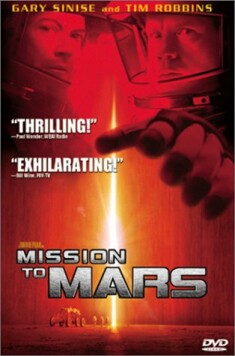Mission to Mars
Brian De Palma is a talented director, but he really needs to get himself
some better writers. Mission to Mars is full of clever ideas, which are
too rare in the movies, and spectacular, computer-generated special effects,
which are not nearly rare enough, but much of the dialogue is cornball stuff
that could have come straight out of an old Buck Rogers movie. Is the spaceship
available to Woody (Tim Robbins) and Ray (Armin Mueller-Stahl) up to the demands
of a rescue mission to Mars to retrieve marooned Luke (Don Cheadle)? “On paper,
yes but those stresses have never been tested in practice,” says Ray.
“The ship can take it,” cocky fighter jock Woody assures him.
But who is to man it? Woody wants Jim (Gary Sinise) who knows more about Mars
than anyone. So what if he’s had a few psychological problems on account of the
death of his wife, Maggie (Kim Delaney), whom he obsessively watches on video?
“What was his crime?” asks Woody. “That he showed a little emotion?” Ray has
nothing to say. “You give me McConnell as a co-pilot and we will bring Luke
home. That’s a promise.” Ray does. And, boy, is he glad too. When disaster
strikes and the rescue crew has to improvise, who do you think saves the day?
“They used the remo as a lander?” says Ray, full of admiration. “It’s Jim
McConnell. Nobody else could have pulled this off. Nobody.”
You get the idea. Could De Palma be doing this deliberately? I began to think
so when he showed us his alien, which looked like an even more elongated and
feminized version of the big-eyed dolls they sell in the souvenir shops around
Roswell, New Mexico, only with long, E.T.-like fingers. It was as if the art
department had hardly even tried to think up anything original. When the
astronauts and this feeble attempt at an alien all held hands in a circle, the
audience on the night I saw the picture was all a-titter. Was De Palma putting
us on? If so, it was hard to see to what end. It is certainly a defensible view
that it is impossible to make a science fiction movie anymore that is not
cheesy, so you might as well play up the cheesiness and share the joke with the
audience. But if you do that, you ought to make the joke funnier and not look as
if you don’t know it is a joke.
The metaphysical dimension to the ending is also an embarrassment. For no
particular reason that we can see, Jim McConnell, decides that going with the
aliens while the other crew members return in their cumbersome, relatively
low-tech Earth-made space vehicle, is the way to return to his dead wife. Though
the alien has not said a word, Jim is convinced that he has “an invitation….to
follow them home. I’m going. It’s what I was born for. It’s like Maggie said,
‘to stand on a new world and look beyond it to the next one’.” Fine words. But
as we leave Jim in the sleek alien saucer, inexplicably underwater but
transfigured by what he sees there, we find that his beatific vision is nothing
but a re-run of the Maggie-highlights video. We think, as we do with the rest of
the picture, that the experience of extraterrestrial life ought to be less
familiar, both to Jim and to us.
Discover more from James Bowman
Subscribe to get the latest posts to your email.








